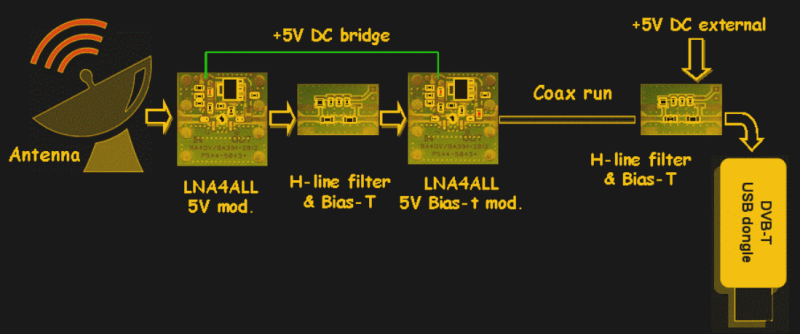It may not be the radio station with all the hits and the best afternoon drive show, but 1420.4058 MHz is the most popular frequency in the universe. That’s the electromagnetic spectral line of hydrogen, and it’s the always on the air. But studying the H-line is a non-trivial task unless you know how to cascade low-noise amplifiers and filters to use an SDR for radio astronomy.
Because the universe is mostly made of hydrogen, H-line emissions are abundant, and their distribution can tell us a lot about the structure of galaxies. The 21-cm emission line is so characteristic and so prevalent that we used it as a unit of measurement on the plaques aboard the Pioneer probes as well as in the instructions for playing back the Voyager recordings. But listening in on 21-cm here on Earth requires a special setup, which [Adam (9A4QV)] describes in a detailed paper on the subject (PDF). [Adam] analyzes multiple configurations of LNAs and filters, both of which he sells, to determine the optimum front-end for 21-cm work. His analysis is a good primer on LNAs and explains why the front-end gear needs to be as close to the antenna as possible. Using his LNAs and filters and an SDR dongle, a reasonable 21-cm rig can be had for about $200 or so, less the antenna. He promises a follow-up paper on homebrew 21-cm antennas; we’ll be looking forward to that.
Not keen on the music of the spheres and prefer to listen to our own spacecraft instead? Then read up on the Deep Space Network and how you can snoop in.
















I followed the link and it’s an excellent article. It mentions that other LNAs are available and the QPL9065 has much better specs than the PSA4-5043.
0.55 dB NF compared to 0.75 and 37.5 dB gain compared to 18.4.
The problem with putting the bandpass filter *after* the LNA is that an interferer can put the LNA into compression and you’ll have no idea that it happened – so the interferer still kills you. If you use a really wideband antenna, you can easily get flattened by cell towers, FM radio stations, etc. A narrowband antenna helps, but given how strong some interferers are, you might still need a quiet environment or a good out-of-band rejection filter no matter what.
Timely stuff! I’m trying to learn LNA noise & impedance matching for finding out if making single-transistor active elements is a good idea. Regenerative frequency dividers, mixers, and all-pass filters for phased arrays are on my list. :)
It is apparently also possible to make a band-pass / band-stop filter with gain. This could address the problem Pat talks about here above.
With the LNA at the feed, you do not have the loss from cabling, connectors, transitions or PIM.
Stop band filtering may provide some benefit, as does location, especially in urban areas, flooded with garbage radiators…baby monitors, microwave ovens, and more.
Stray RF can degrade any receiver’s performance, as does dynamic range. Modest cost SDR receivers do not have good dynamic range, and if on 21 Cm, that problem will show its head. Strong OOB signals will sap your receive capability.
Cavity/stripline/lumped element filters after tge LNA, can allow other, close frequencies to enter and degrade performance.
Stage gain can also severely degrade sensitivity. Balanced stage gain is necessary in order to maimize sensitivity, while minimizing interstage overloading.
3rd order intercept needs to be controlled. Match LNA gain with the output to additional amplifiers. Too much output fed to precedjng stages destroyes dynamic range, creates added noise, and can overload subsequent stages. Thermal noise must also be taken into account for a good S/N ratio.
Great article!
Thanks for the read.
Im building a hydrogen line telescope with an airspy and array of directional helix antennas wrapperd for 1420mhz Fc. Im using two PSA5-5043 based LNA’s for the line driving amp, and im going to use Mini-Circuits CMA-162LN+ as the first stage amp. The radio and amp will all be temp stabilized using TECs in order to keep gain drift to a minimal.
I haven’t really decided on a filtering system yet. I live in a pretty rural area in the mojave dessert. How can I tell if out of band signals are degrading my reception at 1420mhz? For instance if an SDR program shows my noise floor at 1420mhz at -90db with a 50 ohm term and with an antenna am I good? When I do a wide band scan I don’t see any signals over -30db or so, nothing peaking over 0dm for sure. As far as filtering I had just planned to use notch stubs between the two line driver LNAs and as low loss as possible band pass filter behind the first stage LNA.